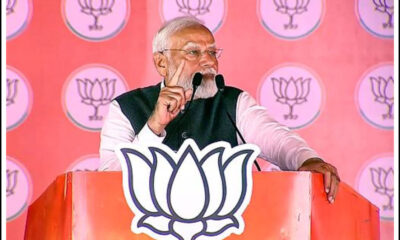CINEMA
Heeramandi: The Diamond Bazaar Review – Beyond The Stunningly Exquisite Methods Using Sanjay Leela Bhansali
Published
2 weeks agoon

Bhansali brings out the best in the six main cast members—Manisha Koirala, Sonakshi Sinha, Aditi Rao Hydari, Richa Chadha, Sanjeeda Sheikh, and Sharmin Segal—in Heeramandi: The Diamond Bazaar review
The artistic and extravagant female-led period drama that is Sanjay Leela Bhansali’s debut online series is packed with all the elements that make the filmmaker’s big-screen endeavors renowned. Massive and opulent settings, visual magnificence, strong feelings, stylistic flamboyance, extended musicianship, and remarkable performances are all present. Exists another one? Indeed, there is.
Heeramandi: The Diamond Bazaar reimagines the red-light district and 1940s Lahore with significantly less attention to detail accuracy and more focus on the overall impact of the project. There are moments of radiant beauty in the play. There are also sporadic moments where the tone becomes stagnant and the film looks sterile. However, when all is said and done, its advantages greatly exceed its disadvantages.
The lavish eight-episode Netflix series, which makes absolutely no cuts, is the brainchild of Bhansali, who also serves as its editor, music director, co-writer (with Vibhu Puri), and creator. It is filmed in its entirety to resemble the widescreen extravaganza that it is meant to be.
Heeramandi: The Diamond Bazaar, which is based on an original idea by Moin Beg, juxtaposes the story of the legendary but exploited courtesans of Lahore with the fast-moving movement for freedom being fought by a group of underground rebels.
Bhansali uses moderation to temper his maximalist approaches. During the turbulent latter years of the British Raj, when the nawabs, who were the main patrons of the nautch ladies of Heeramandi, were rapidly losing their influence, the series is both a celebration and a lament for a home of feisty courtesans yearning for dignity and liberation.
The six main cast members—Manisha Koirala, Sonakshi Sinha, Aditi Rao Hydari, Richa Chadha, Sanjeeda Sheikh, and Sharmin Segal—are expertly crafted by Bhansali.
Read also:-For violating the IPL Code of Conduct, Hardik Pandya was fined Rs. 24 lakh; other Mumbai Indians players received same punishment
Returning to a Bhansali project 28 years after Khamoshi: The Musical, Manisha Koirala plays two fierce women who represent the two main poles of the struggle for control: Sonakshi Sinha, fresh off the victory of Dahaad.
However, Aditi Rao Hydari, who is portrayed as the personification of elegant grace and refinement, is given a broader range of emotions to choose from. Sanjeeda Sheikh plays a damaged lady at the losing end of a bitter power struggle between forces far stronger than her, and Sharmin Segal plays an innocent but bright young woman who wants to escape her destiny. Both actors have their moments.
The way Bhansali uses the power of the supporting cast, especially Farida Jalal, Nivedita Bhargava, Jayati Bhatia, and Shruti Sharma, to create a sophisticated, if self-consciously stylized, portrait of a turbulent period and a distinct culture caught in a maelstrom caused by the whims of history and the narrow-mindedness of self-serving men, is equally impressive.
Much less effective is the male cast, whose performers portray minor characters who make decisions for the courtesans or run the city’s law enforcement apparatus. It stars Shekhar Suman, who has also been absent from the cinema for years, and Fardeen Khan, who is returning to the big screen after a 14-year break.
The drama revolves around the roles that Khan and Suman play, which are that of nawabs with the tawaifs of Heeramandi, mistresses in a give-and-take relationship that errs on the side of distrust and want.
Greater screen time is given to three other male actors: Indresh Malik, who plays a cunning middleman between the naughty girls and their erratic sponsors; Jason Shah, who portrays a brutal British police officer; and Taha Shah, who plays the well-connected and strategically compliant son of an aristocrat who rebels against his father and the British. They take full advantage of it.
Adhyayan Suman, who also plays the younger iteration of Shekhar Suman’s character, plays one of Heeramandi’s patrons, proving that the wealth and attention a debauched nawab bestows upon a tawaif, Lajjo (Richa Chadha), are fleeting. They are a part of a Faustian contract that is simple to break.
Misery isn’t limited to cunning outsiders. Because of their need for validation and self-assertion, the nautch females themselves are equally capable of hurting each other with jealous outbursts and betrayal. Even though the Heeramandi courtesans are a close-knit group of people—the most of them are related by blood—they nonetheless constantly trade insults, both verbal and psychological.
The majority of the series takes place in two homes that are situated across from one another in the seedy neighborhood that the wealthy and powerful frequent. One is Shahi Mahal, which means “royal palace,” where Manisha Koirala, an experienced Mallikajaan, is the unchallenged queen.
On the other hand, the younger Fareedan (Sonakshi Sinha) relocates from Benaras to the much sought-after mansion known as Khwabgah (literally “house of dreams”). The only child of Mallika’s deceased older sister, Fareedan, is vengeful towards the people of Shahi Mahal.
Mallikajaan and her kind are sustained on dreams and delusions of grandeur. As one of the women puts it, dreams are their deadliest enemy. She continues, “We can only see them, but we never realize them.” The drama of the courtesans’ precarious lives is centered on their constant oscillation between optimism and despair.
Heeramandi: The Diamond Bazaar maintains its focus on the women while sprinkling its expansive, overflowing canvas with unfolding processions, street fights, and instances of torture in detention that leave a trail of blood and unspeakable horrors, as well as with intimate moments of love, jealousy, deceit, and rebellion.
The tawaifs, who live in the center of Lahore, are at once seductive and melancholic, poignant and dominant, but they are destined to exist only as disposable objects of fancy on the periphery of a society ruled by nawabs on the verge of extinction and brutal British officials desperately holding onto power over an increasingly restless colonized populace.
Although the cards are stacked against the courtesans, they are the ones in charge of the wealthy men who provide for them emotionally. But for how long can they hold the nawabs in their thrall and defend their precarious territory?
The courtesans find themselves caught in a cleft stick as the rumblings of the swadeshi movement spread to Heeramandi, drawing Mallika’s two daughters, Bibbojaan (Aditi Rao Hydari) and Alamzeb (Sharmin Segal), both directly and unintentionally, into the independence struggle. They had the option of joining the freedom fighters or siding with the nawabs, who lack the bravery to oppose the British.
At first glance, the elaborately mounted Heeramandi might seem like a typical SLB project. It uses lovely imagery paired with poetry and music to tell the story of a little-known but fictitious period in the subcontinent’s past. It is only reasonable to assume that it does so with constant competence.
Four DoPs are credited with the cinematography: Sudeep Chatterjee, a frequent collaborator of Bhansali, Mahesh Limaye, Huenstang Mohapatra, and Ragul Dharuman; Subrata Chakraborty and Amit Ray are responsible for the production design. The technical contributions from both sides to the event are faultless.
Though Bhansali uses opulent methods that are both bright and distracting, there is more to the series than that. One important lesson to be learned from Heeramandi’s approach is: According to The Diamond Bazaar, the movement that fought for India’s freedom rejected the Crown’s divide and conquer strategy.
As they plan attacks on the British, Muslims and Hindus stroll side by side. The fighters are not divided by their religious affiliations. They are united by their dedication to azaadi. The defense of the subcontinent’s deeply ingrained syncretism is an important thematic thread in the context of contemporary India, and it shouldn’t be overlooked amidst the mesmerizing glow of the opulent Heeramandi cosmos that Bhansali creates.
Heeramandi: It’s not all glitz and glamour at the Diamond Bazaar. Enchanting and solemn, its essence surpasses the splendor and brilliance of its presentation.
Cast:
Manisha Koirala, Sonakshi Sinha, Aditi Rao Hydari, Richa Chadha, Sharmin Segal, Sanjeeda Shaikh, Fardeen Khan, Adhyayan Suman, Shekhar Suman and Taha Shah Badussha, Farida Jalal
Director:
Sanjay Leela Bhansali
Credent TV Editorial Team

You may like
-


On the Citizenship Amendment Act (CAA), PM Narendra Modi challenges Congress and the SP
-


Shortly After Slovak PM’s Assassination, As Crowd Held Gunman
-


Vladimir Putin, the leader of Russia, makes a state visit to China as a symbol of the alliances’ solidarity
-


NASA: Bright, tiny, plant-like creatures discovered in the Celtic Sea
-


Earth’s North Pole is moving more quickly
-


Following the helium leak, Starliner is now aiming for a May 21 launch.
